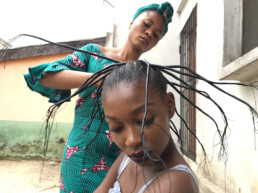„The Art of African Hair Threading“ – a short film by Nigerian fashion designer Busayo Michelle Olupona – is dedicated to a traditional method of Afrohair styling. Among other videos and short films, it is currently running a loop in the Afro Hair District of the exhibition Connecting Afro Futures. Fashion x Hair x Design at Berlin’s Museum of Decorative Arts. In this interview we learn more about the film and the woman behind it.
Busayo Michelle Olupona founded her fashion label because of „the belief in the power of color to communicate the dynamism, personality and nuances of the individual.” She grew up in Nigeria and now lives and works between Lagos and New York City. She is interested in exploring traditions and the ways in which they inform the present.
With the fashion label, came photoshoots and the topic of styling – specifically hairstyling – more to the fore. She re-encountered the hairstyles of her childhood in a new light: “Over the last few years, I have undergone a transformation of sorts, a return to and reintegration of childhood traditions and aesthetic, stylistic choices that I had aggressively dismissed as a child from fashion to hair, my aesthetic choices have become distinctly Nigerian.”
One result of this interest is her short film about African Hair Threading – about the method of styling hair in which hair is wrapped with thread to create sculptures and static structures on the hair.

What started you on the journey towards making your video “The Art of African Hair Threading”? What went into the production process?
I am primarily interested in how we as Africans can both in aesthetic, lifestyle and cultural choices can return to and embrace what makes us different and unique in the world. The video was about exploration the most indigenous of our hair traditions particularly considering the fact that hair threading is so complex, some people hate it, some find it painful and yet it is the sort of a singularly specific reclamation of an African identity. And there is tremendous power in the style and what it says to the world about who you are.

How has the video been received so far? Have any of the reactions you got stood out to you?
The reception was far beyond my expectations, I was exploring my own curiosities and attempting to understand my own changed relationship with the hairstyle. I use to hate it as a kid and yet as I have gotten older the very thing that I ran away from like our clothes and our hair is what excites me now. It really wasn’t about the world response. However, it struck a chord, because I think we are all struggling with these same issues, what I was most excited about was the conversation that it sparked and the ways African women from across the continent were connecting with each other as they discussed the video.


Where are you at your most creative and what is the DNA of your creative process?
Nigeria, for sure. I pursue my curiosities, what are the questions I have about our indigenous practices, what are traditions that I don’t understand and wish I knew more about. I follow my muse. I can’t really dissect it.
How do you see the intersection of Fashion Design and Hair Styling?
Hair and Fashion are certainly deeply connected. The way one interprets fashion is deeply dependent on its context and hair is a fundamental part of that context. I think of the presentation as one complete whole.


Why is the interest in traditional African hairstyles increasing? What do you think are the causes of that?
Interest from whom? Black people have always been interested in hair. I do think the exposure of traditional African threading caused some excitement because some Black people across the diaspora hadn’t really seen it before. If you mean from the mainstream culture, I think Black culture has always been a source for imitation, originality and dopeness in general. I do worry that by sharing these very culturally specific and beautiful parts of our culture with the world, it will be cannibalised.
What’s next for you, do you have other hair projects planned?
I will continue my exploration of the indigenous and the original in our pre-colonial selves, hair will definitely factor in some way, but not sure how just yet.
—
Follow @busayonyc on Instagram
Connecting Afro Futures. Fashion x Hair x Design is at Berlin’s Museum of Decorative Arts until December 1st.
Connecting Afro Futures.
Fashion × Hair × Design
Funded by the TURN Fund of the German Federal Cultural Foundation / Gefördert im Fonds TURN der Kulturstiftung des Bundes
Project Partners / Projektpartner
Kunstgewerbemuseum / Museum of Decorative Arts, Berlin; fluctuating images, Berlin; Fashion Africa Now, Hamburg; Goethe-Zentrum Kampala; Ugandan Arts Trust, Kampala; Wakh’Art, Dakar.

